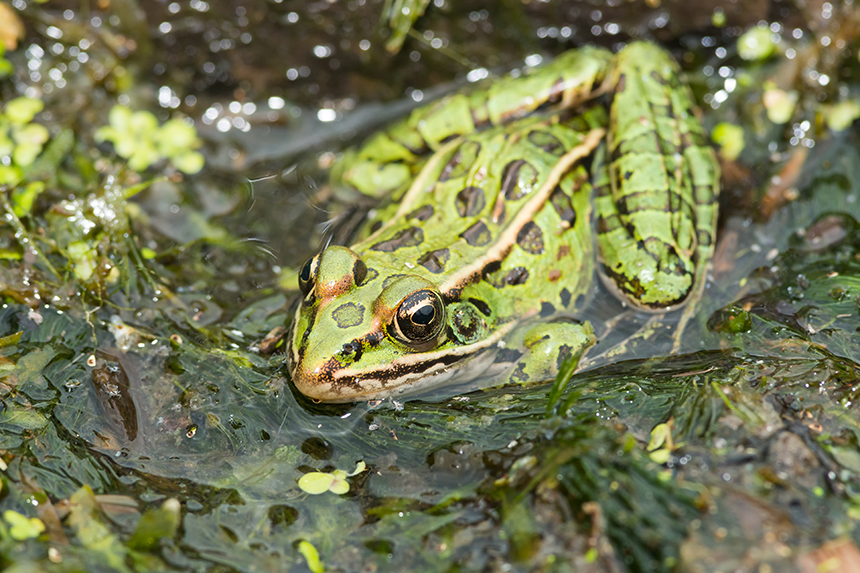By TODD McLEISH/ecoRI
News contributor
 When Scott Buchanan was
hired as a wildlife biologist at the Rhode Island Department of Environmental
Management last year, he became the first full-time herpetologist on the state
payroll.
When Scott Buchanan was
hired as a wildlife biologist at the Rhode Island Department of Environmental
Management last year, he became the first full-time herpetologist on the state
payroll. It’s a sign, he said, that reptiles and amphibians are in need of management and conservation in the state.
“To be in herpetology is
to be on the front lines of the global biodiversity crisis,” he said.
“We’re at risk of losing, globally, roughly half of the reptile and amphibian species on Earth in the next 100 years. Turtles and frogs are in a neck-and-neck competition for the unfortunate title of being the most endangered wildlife taxa.”
“We’re at risk of losing, globally, roughly half of the reptile and amphibian species on Earth in the next 100 years. Turtles and frogs are in a neck-and-neck competition for the unfortunate title of being the most endangered wildlife taxa.”
While Rhode Island’s reptiles and amphibians haven’t experienced the level of habitat loss and disease that occurs in Southeast Asia or the tropics, Buchanan said “the crisis is very real in New England.
The mission is very urgent, and we need to do everything we can here in Rhode Island.”
About 40 species of
turtles, snakes, frogs, toads, and salamanders call the Ocean State home. All
face issues of habitat loss, road mortality, and disease, but turtles are also
faced with high demand from collectors for the pet trade.
While monitoring a rare
population of wood turtles this spring, herpetologist Lou Perrotti, director of
conservation at the Roger Williams Park Zoo, observed a small specimen he
estimated to be 5 or 6 years old.
“I love to see the
little ones,” he said, “but I worry that someone would put this one in their
pocket and take it home.”
It’s such a concern that
Buchanan is co-chair of a collaborative group of biologists, law enforcement
officials, and legal experts from up and down the East Coast working to combat
the illegal trade in native turtles.
The objective, he said, is to raise the profile of the issue and encourage the law-enforcement community to be aware that a black market in native turtles exists in the region.
The objective, he said, is to raise the profile of the issue and encourage the law-enforcement community to be aware that a black market in native turtles exists in the region.
The illegal trade in
wildlife is valued at about $19 billion annually, according to the World
Wildlife Fund’s TRAFFIC program, a
network of organization that monitors the trade.
“It’s something I worry
a lot about,” said Buchanan, who conducted research on spotted turtles for his
doctorate at the University of Rhode Island.
“If you know where they are, turtles are pretty easy to pick up, take home, keep alive, and get them into the black market. All of our native species are vulnerable, though some are more prized than others.”
“If you know where they are, turtles are pretty easy to pick up, take home, keep alive, and get them into the black market. All of our native species are vulnerable, though some are more prized than others.”
A Pennsylvania man was
arrested last year for smuggling 3,500 rare diamondback terrapins from marshes
in New Jersey and selling them online. Although no cases have been adjudicated
in Rhode Island, Buchanan said there is evidence of the illegal turtle trade in
the state.
Buchanan is also
involved in region-wide efforts to study spotted turtles and box turtles, two
species that are considered to be of significant conservation concern. He is
conducting surveys of both species in Rhode Island this spring to gather as
much data as possible about their distribution, abundance, demography, and
population genetics.
In collaboration with
Roger Williams Park Zoo and Brown University, he is also investigating the
presence of disease in local populations of reptiles and amphibians.
“We need to improve our
understanding of where the diseases are and what species are harboring them to
get a sense of their susceptibility,” Buchanan said.
“There’s chytrid [a common amphibian disease in the tropics] in our environment, though our frogs don’t seem to be susceptible, but there hasn’t been a lot of testing. And there’s a similar disease for salamanders that has had bad outbreaks in Europe, and we’re worried about it coming overseas.”
“There’s chytrid [a common amphibian disease in the tropics] in our environment, though our frogs don’t seem to be susceptible, but there hasn’t been a lot of testing. And there’s a similar disease for salamanders that has had bad outbreaks in Europe, and we’re worried about it coming overseas.”
Two species of amphibian
— the eastern spadefoot toad
and northern leopard frog —
are on the verge of disappearing from Rhode Island. Both have only one known
population. The toad is only found at one site in Richmond, though efforts are
under way to create habitat to
establish additional populations.
The northern leopard
frog is found only on the border of Bristol and Warren, and Buchanan said there
is little that can be done to help it recover.
“The northern leopard
frog might be the best example of a species that’s about to disappear from the
state,” he said, noting that the species faces multiple threats from habitat
loss, pollution, and invasive species. “It could happen this year, next year,
or in five years, but all indications are it’s going to happen soon. And
there’s not a tool in my toolbox at the moment that I can use to confront the
situation.”
Rhode Island resident
and author Todd McLeish runs a wildlife blog.